PMD is a source code analyzer. It finds common programming flaws like unused variables, empty catch blocks, unnecessary object creation, and so forth. It supports Java, JavaScript, Salesforce.com Apex and Visualforce, PLSQL, Apache Velocity, XML, XSL.
Additionally it includes CPD, the copy-paste-detector. CPD finds duplicated code in Java, C, C++, C#, Groovy, PHP, Ruby, Fortran, JavaScript, PLSQL, Apache Velocity, Scala, Objective C, Matlab, Python, Go, Swift and Salesforce.com Apex and Visualforce.
Please note, that this module requires a Java 8 runtime environment.
 Use link – https://dl.bintray.com/pmd/pmd-eclipse-plugin/updates/
Use link – https://dl.bintray.com/pmd/pmd-eclipse-plugin/updates/
to install PMD Software in eclipse from Help->Install New Software->Add Repository.
After installation Just right click on your project and select ‘Check Code‘ in PMD
You can generate PMD report which create Report folder in your project location.
